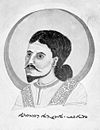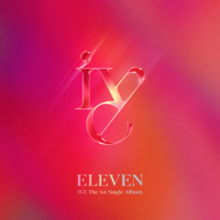생명의 나무의 숭배
Veneration of the Tree of Life| 생명의 나무의 숭배 | |
|---|---|
 하진이 베낀 벽화의 컬러 그림 | |
| 아티스트 | 알 수 없는 |
| 연도 | 9~11세기[1]: 230 |
| 유형 | 벽화 |
| 치수 | 180cm × 280cm(71인치 × 110인치) |
| 위치 | 베제클리크 천불굴, 투르판 |
생명의 나무 숭배는 중국 신장 투르판 베제클릭 동굴 38번(크렌바이델 25호)의 마니차이안 프레스코로 생명숭배 현장의 마니차이 나무를 그린다. 이 종교의 가르침에 따라 빛의 왕국에는 생명의 나무가 자라고 있다. 그것은 세 개의 줄기를 가지고 있는데, 이것은 빛 왕국의 동서남북을 상징한다. [2]
개요
이 프레스코화는 20세기 초에 발견되어 이미 심하게 훼손되었다. 연구를 용이하게 하기 위해 독일의 고고학자 앨버트 그룬웨델이 흑백 선 스케치를 그렸고, 프랑스 고고학자 조셉 해킨이 컬러 그림을 베꼈다. [1]: 229–231
그림의 중심에는 세 개의 줄기가 있는 생명의 나무가 그려져 있다. 그 나무는 가지가 무성하고 잎이 무성하며, 꽃이 만발하여 향기로운 꽃과 수많은 열매가 맺혀 있다. 나뭇가지에 커다란 포도 뭉치가 매달려 있다. 나무 전체가 거대한 캐노피처럼 보인다. 나무 아래의 수영장은 치바오 향수로, 수영장에 있는 두 마리의 새가 숭배하는 군중을 바라보고 있을 것이다. 트렁크 좌우에는 생명의 나무를 경례하는 여섯 사람이 있었다. 그들 중 네 명은 앞에서 무릎을 꿇고 있었고 두 명은 뒤에 서 있었다. 그들은 옷을 잘 차려입고 풍성하게 장식된 높은 관을 쓰고 있다. 그 중에는 날개를 가진 천사, 신자, 그리고 다른 신들이 있다. 천사의 이름과 찬양, 서약은 위구르어로, 그림 아래 수영장과 사이드바에 적혀 있다. [3]
Below the incense pond, there is a Uyghur script written in Uighur letters in vertical lines, similar to the prayers: "This is a gathering of the patron saints", "I, Savit, in front of the peacock portrait, write all this, I hope not There is no more sin, I hope [...] be protected", "Otukan Ingesakank (and) Quartluk Tan Misu Kea, I hope they are pr[...] 나는 겸허하게 이 모든 일을 끝내고 나서 [...] 평화가 있기를 바란다. 내 죄를 용서해 주시오." 기도문 내용 중 프레스코화가 포함된 것도 있지만 원저자가 남긴 말은 아니다. [1]: 231–233
참고 항목
참조
- ^ a b c Gulácsi, Zsuzsanna (2015). Mani's Pictures: The Didactic Images of the Manichaeans from Sasanian Mesopotamia to Uygur Central Asia and Tang-Ming China . "Nag Hammadi and Manichaean Studies" series. 90. Leiden: Brill Publishers. ISBN 9789004308947.
- ^ Ma Jian (2006-11-01). "Remains of Manichaeism in Turpan". dsr.nii.ac.jp (in Chinese). Retrieved 2019-05-02.
- ^ Chao Huashan (1992). "Explore the Annihilated Turpan Mani Temple (Part 1)". Theological Collection (in Chinese) (94): 561–570. Retrieved 2019-06-23.
Cave 38 (German's Cave 25) was first built, and the depth was short. After using it for a long time, it was smoked black. Later, the cave was lengthened and became the shape shown in this picture, namely the 38B cave. This cave has a main chamber and a back chamber. The middle section of the main chamber’s starting wall has a lower wide passage connecting the adjacent cave 39A. In front of the starting wall, there is a platform with a width of 120 cm and a height of 40 cm. The front wall also has the same height. However, for a platform with a width of 150 cm, the lower half of the front wall is recessed about 40 cm into the wall, and the arcuate surface of the upper half is not recessed. A low passage is opened on the front side of the front wall to enter the back chamber, which is connected to the adjacent cave 39. The architectural form of this cave is quite special. The wall of the main room is painted with a layer of white mortar, and the arcuate surface of the front wall is painted with colorful murals directly on the white and gray surface without other background colors. There is also a row of murals in the same way on the lower edge of the abdomen on both sides of the coupon. The arch-shaped mural on the front wall is a tribute to the tree of life. In the center of the picture is the tree of life. The three trunks of the tree grow out of a circular pool. In the pool, there are a pair of swans. The tree blooms with twelve large flowers and bears many fruits. On both sides of the tree, there are believers, angels, and gods to praise and repent. The praise, angel name, and vow are written in Uighur, written in the pool, and in the sidebar under the painting. There are three paintings on the bottom edge of the coupon frame. There are three paintings in the middle of the end, one of which is an enshrined flame orb, and the other two are of Ji Le Ren. There is a row of decorations under the frame. The painting on the belly of the front side coupon has fallen off. According to Glen Weddell's record, one is a picture of the universe, but it is actually a picture of a Manichaean temple; the other is a portrait of a Persian Manichaean believer.




